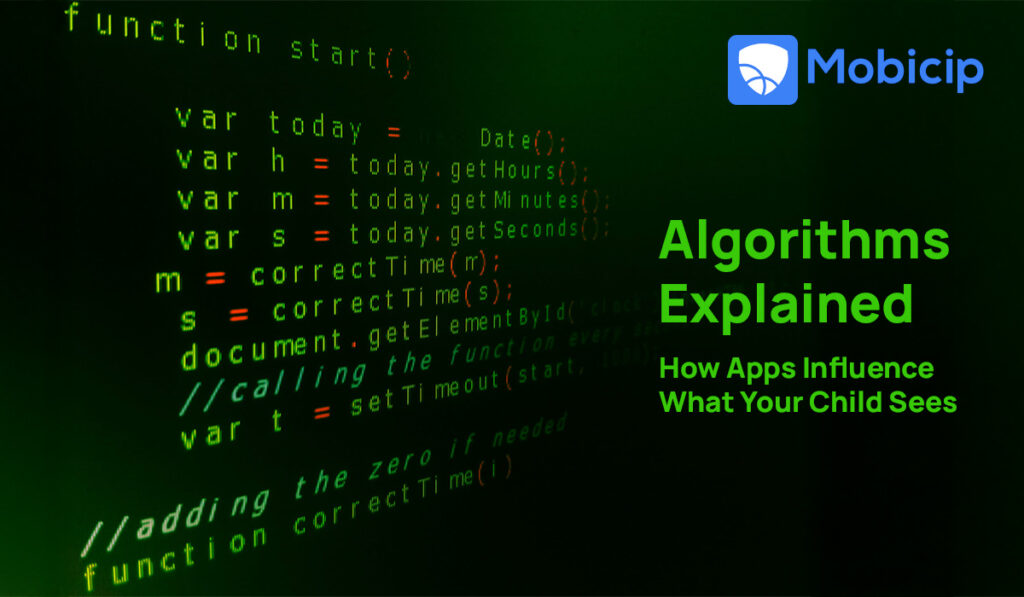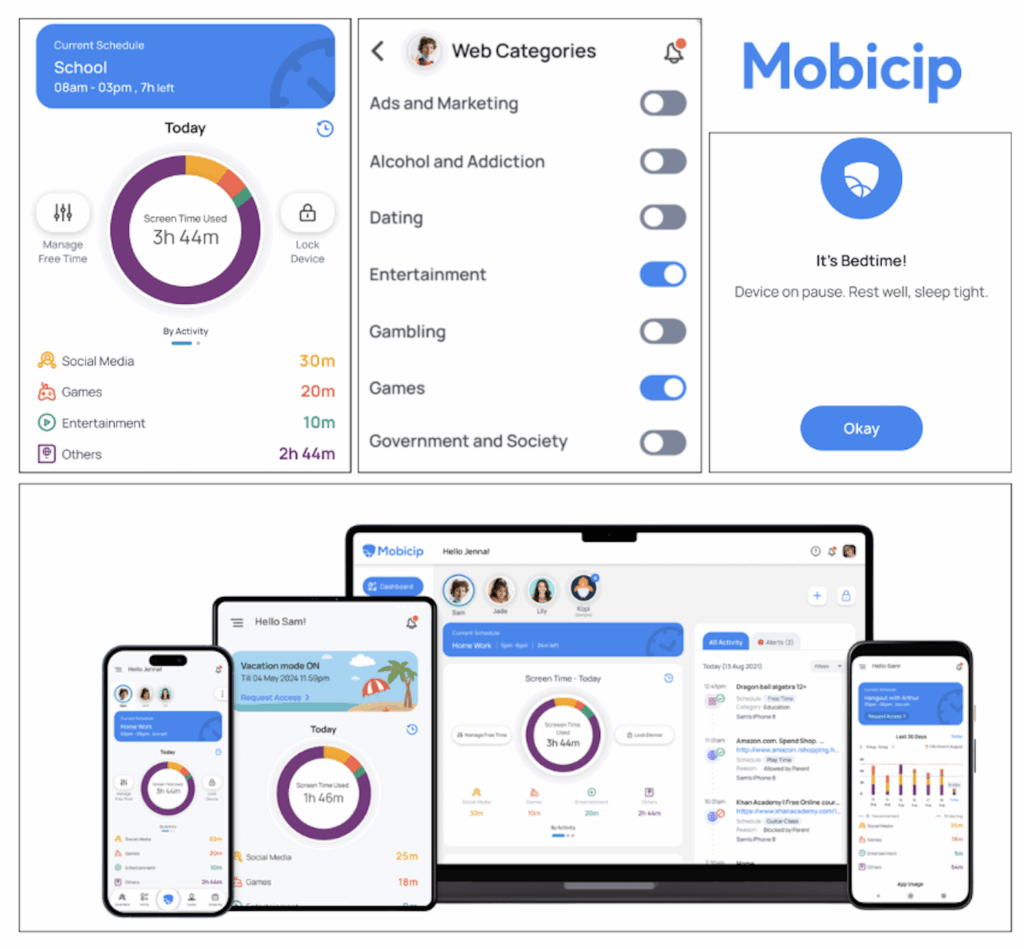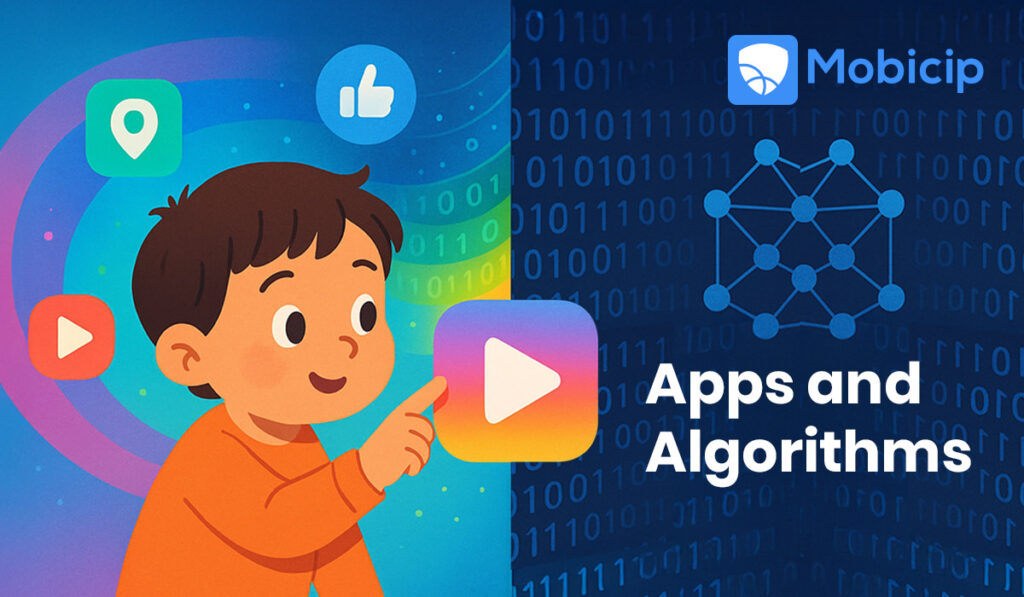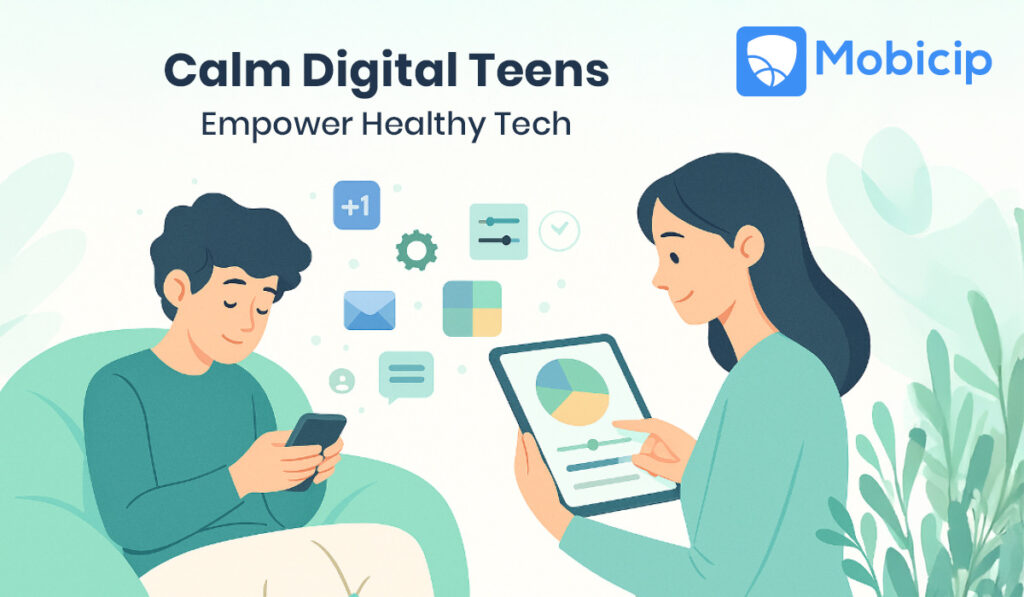Social Media Algorithms: How Apps Influence What Your Child Sees Every Day

An algorithm is simply a set of step-by-step instructions that a computer follows to get something done. Think of it like a recipe: if you want to bake a cake, you follow the steps in order—mix the flour, add sugar, bake at the right temperature—and the result is the finished cake. Computers do the same thing with information, except much faster and on a much bigger scale.
On social media, algorithms work like invisible chefs, mixing and serving the posts our children see. They watch what kids like, share, or even pause on, and then serve more of the same. This can be fun and engaging, but it also means what our children see every day is carefully shaped, not random.
In this essay, we’ll look at how algorithms work, the different types behind our apps, and why they matter for families. Thankfully, tools like Mobicip can help us guide these feeds in healthier directions.
Types of Social Media Algorithms
Social media platforms don’t rely on just one algorithm. Instead, they use a combination of systems that work together to decide what shows up on your child’s screen. These algorithms act like filters and organizers, each with a specific role. Let’s look at the main kinds.
Recommendation Algorithms
These are the engines behind “For You” pages or “Suggested Posts.” They analyze what a child has liked, watched, or searched for and then suggest new content that matches those interests. This is why one video about pets can quickly turn into an endless stream of cute animal clips.
Ranking Algorithms
When your child opens their feed, they don’t see posts in the order they were uploaded. Ranking algorithms score each post based on predicted interest—likes, comments, or watch time—and then arrange them so the most “engaging” content appears first.
Moderation Algorithms
These are the safety guards. They scan posts for harmful or inappropriate material, such as violence or explicit language. While not perfect, they help reduce the chances of children seeing dangerous content.
Advertising Algorithms
Ads are also personalized. These algorithms study behavior and demographics to decide which products or games to show. For children, this can mean more ads for toys, apps, or even energy drinks.
How Social Media Algorithms Decide What Children See
Every time a child scrolls, taps, or pauses on a video, they are feeding information back to the app. Social media platforms use this constant flow of data to decide what to show next. The process feels invisible, but it follows a clear logic.
Tracking Behavior
Algorithms watch for signals: what videos are liked, which posts are shared, how long a child spends watching, or even what they scroll past quickly. All these little actions are stored as data points.
Analyzing Content
Every post—whether it’s a meme, a video, or an ad—has its own tags and labels. For example, a cooking video may be tagged as “food,” “recipes,” and “family.” The algorithm matches these tags with the child’s past behavior.
Predicting Interest
Using machine learning, the algorithm predicts the chance a child will enjoy each piece of content. It may calculate: “There’s a 70% chance they’ll watch this video fully” or “an 80% chance they’ll like this post.”
Ranking and Displaying
Posts with the highest predicted scores are pushed to the top of the feed, while less relevant ones are hidden. That’s why two children can follow the same accounts but see completely different feeds.
Learning and Adapting
The cycle repeats as the child keeps interacting. The more they watch, the smarter the algorithm gets at predicting what will hold their attention.
In short, algorithms decide what children see by learning from their actions, scoring every possible post, and constantly reshaping the feed to maximize engagement.
The Good, the Bad, and the Ugly of Social Media Algorithms
Algorithms are powerful tools that decide what content our kids see online, often without us even realizing it. Like a double-edged sword, they can make digital experiences smoother and more engaging, but they can also create risks we might not notice right away. Let’s break down the good, the bad, and the ugly outcomes of algorithms, and what they really mean for our children’s online world.
The Good of Social Media Algorithms
Algorithms can make social media a more enjoyable and useful space for children. By filtering through millions of posts, they bring forward content that feels personal and relevant. Instead of wading through endless distractions, kids see more of what they like and less of what they don’t.
Some of the good outcomes include:
- Better user experience – Feeds feel smoother and more engaging because they are tailored to interests.
- Encouragement of hobbies and learning – A child who likes science experiments may be recommended more educational videos, fueling curiosity.
- Sense of community – Algorithms connect children with like-minded peers, helping them feel included and supported online.
When used well, algorithms can spark creativity, provide learning opportunities, and connect children to positive communities.
The Bad of Social Media Algorithms
Yet, personalization has a downside. Algorithms can unintentionally narrow children’s digital worlds, limiting their exposure to new ideas.
Some of the bad outcomes include:
- Echo chambers and filter bubbles – Children may be shown only the content they already agree with, reinforcing their views and isolating them from different perspectives.
- Algorithmic bias – Popular posts rise to the top, while diverse or less mainstream voices get drowned out.
- Manipulation and addiction – Feeds are designed to keep kids scrolling, making it hard to log off and easy to get addicted.
These effects can quietly shape how children think, what they value, and how much time they spend online.
The Ugly of Social Media Algorithms
Beyond narrowing interests, algorithms raise deeper concerns about ethics and safety.
Some of the ugly outcomes include:
- Privacy risks – Algorithms use personal data such as age, browsing history, and location to build highly detailed profiles of users.
- Advertising pressure – Personalized ads target children with products, apps, or snacks they may not need, subtly influencing decisions.
- Hidden control – By deciding what to amplify, algorithms can manipulate behavior, encouraging children to believe or buy things without realizing it.
What Parents Can Do
If algorithms quietly shape what children see every day, the natural question is: how can parents step in to balance things? The good news is, while we can’t change how social media platforms are designed, we can guide how our kids interact with them.
Talk about social media algorithms with children
Explain to children that what shows up in their feed is not random. Use simple comparisons like a playlist that changes based on what songs they keep replaying. This helps them understand that their choices shape what they see.\
Encourage variety
Suggest that your child follow accounts on different topics—science, art, hobbies, and positive role models. This prevents the “echo chamber” effect where they only hear the same voices and ideas over and over.
Set boundaries together
Instead of only restricting, involve kids in deciding screen time rules. This gives them a sense of control while still keeping balance.
Model good behavior
Children notice what we do more than what we say. If they see us scrolling endlessly, they’re likely to copy. Being mindful of our own habits sets the tone.
Use parental tools
Apps like Mobicip can help filter harmful content, set healthy screen limits, and give parents insight into what kids are watching without invading their privacy.
With these steps, parents don’t just limit technology—they help their children build healthier, smarter relationships with it.
How Mobicip Can Help
Mobicip is more than just a parental control app—it’s a digital co-pilot that helps families manage online content and screen time in healthier ways. In the context of algorithms, a few features stand out:
- Content Filtering – Mobicip blocks harmful or age-inappropriate websites and apps, so even if an algorithm pushes questionable content, it won’t make its way onto your child’s screen.
- Screen Time Management – By setting daily limits or schedules, you can prevent endless scrolling sessions where algorithms feed kids more and more of the same content.
- App & Social Media Controls – Parents can decide which apps are accessible and for how long, ensuring that children aren’t spending all their time on platforms known for algorithm-driven rabbit holes.
- Activity Reports – Mobicip provides insights into what kids are watching or engaging with, giving parents the chance to spot patterns (like overexposure to a single type of content) and guide kids back toward balance.
- Cross-Device Protection – Whether on a phone, tablet, or laptop, Mobicip applies the same guardrails, helping families maintain consistency across devices.

Conclusion
Algorithms may be invisible, but their fingerprints are all over the digital world our children step into every day. They are not good or bad on their own—what matters is how they are designed, and more importantly, how we engage with them. Like a recipe, algorithms mix different “ingredients”—likes, clicks, and shares—to serve up a dish tailored to each child. Sometimes the outcome is nourishing, offering fresh ideas and positive content. Other times, it can be junk food for the mind, feeding only what’s familiar and creating an echo chamber that narrows perspective.
The challenge, then, is not to reject technology but to learn how to season it wisely. Parents have the power to balance the plate, adding in tools like Mobicip, family discussions, and mindful screen habits. That way, algorithms remain enablers of a healthy meal—not the ones secretly deciding the entire menu.

Related Video:
Video Vault: Discover How Mobicip is Supporting Families in the Digital Age





